


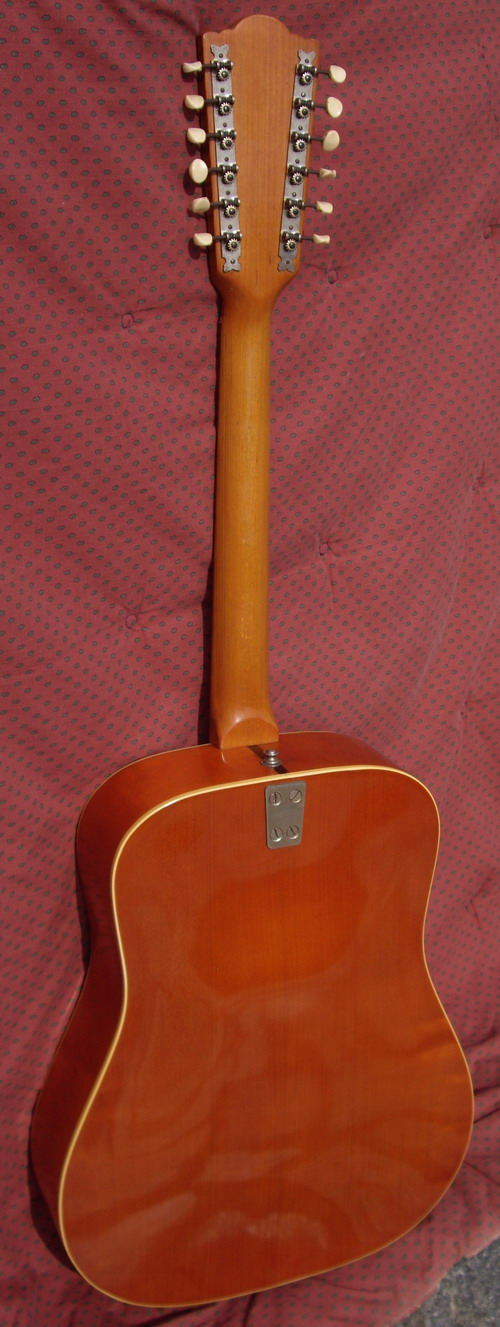

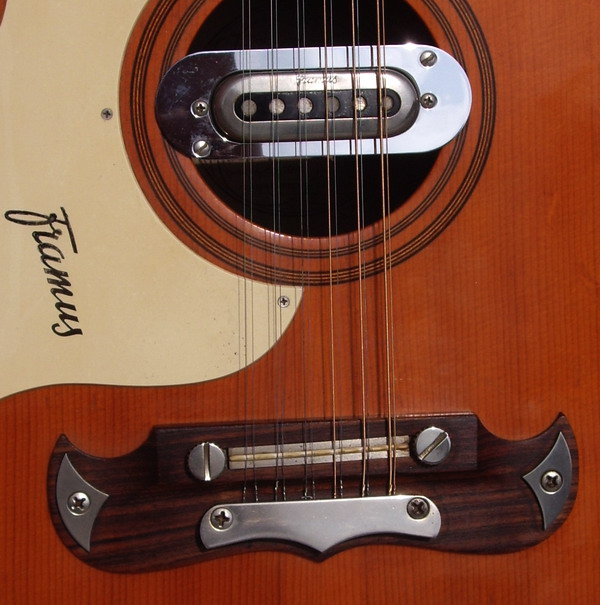
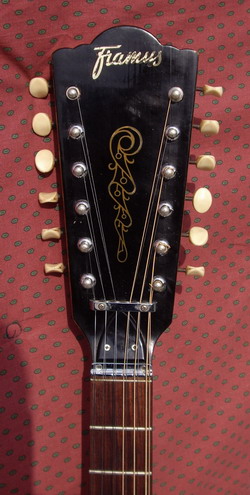
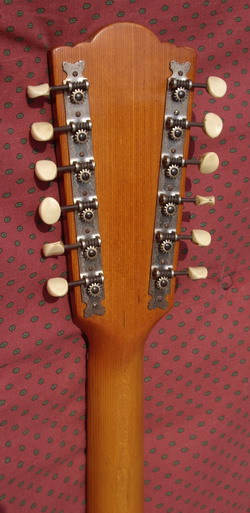
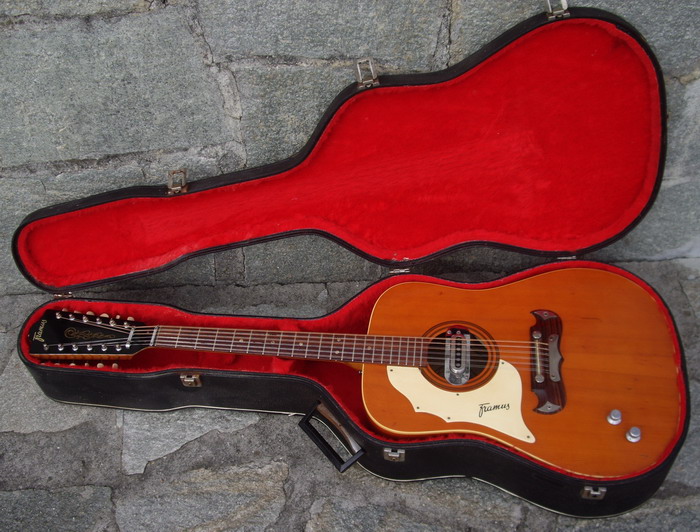
FRAMUS '68 TEXAN 5/296LE Lefty, 12 Strings, Natural, One original Framus PickUp, Volume & Tone Control, RARE, Hard Case EX+ code Lh555
In good working condition Bolt on neck with a soft "V" shape. Frets are in perfect shape. Straight neck and working truss rod.Super plays low action and great sounds! Nice and massive spruce top, maple sides and arched back.Rosewood fingerboard.Personally checked and signed by Framus chief luthier Richard Müller.1.70" nut, 24.75" scale length, 15.75" bottom bout, 3.75" depth
Framus had a folk/western production line in the early sixties that consisted of the models Dix, King, Gaucho and Jumbo. The country and western scene was however considerably more active in the USA than in Germany and that was reflected in the product offering from the factory in Bubenreuth: concentrating on the essentials created the success of the Texan model, which came as a 6- or 12-string guitar. It became one of the top-selling western models of all time. And the millionth Framus guitar at the 25th anniversary of the company wasn’t a King by accident.

John Lennon played a Framus 12-string on "You've Got to Hide Your Love Away"
http://www.reverbnation.com/laurenpaulashley/song/1592996-the-wedding-song
http://www.youtube.com/watch?v=eNqWpleAn0Y
And more...
http://www.youtube.com/watch?v=2e7cNqc-VRo
http://www.youtube.com/watch?v=_bOs0K9u-BQ
http://www.youtube.com/watch?v=CLMzdygiJ3U
http://www.youtube.com/watch?v=lO2yeThuWkE
http://www.youtube.com/watch?v=vb_drAHLugw
http://www.youtube.com/watch?v=eT_NwfloASQ
|
The origin of Framus is to be found in the music town of Schoenbach, today called Luby u Chebu in the area of Eger. The city at the foot of the Erzgebirge was shaped by the music. Violins, as well as all other instruments have been manufactured and exported from Schoenbach to the whole world. In that Bohemian part of the music industry the founder of Framus, Fred Wilfer was born in 1917. In 1945, when he heard about the expulsion plans of the allied forces, which were going to affect his homeland in the Sudetenland as well, he decided to build up a new basis for his countryman and the music industry in the west. Even before the first train was going to transport violin makers from Schoenbach to other areas, Fred Wilfer contacted different government authorities in Bavaria and told them about his plans. The Bavarian government welcomed his plans and asked him to create all conditions needed for the settlement to Bavaria. Since Fred Wilfer was classified as an “anti-Fascist” by the Czechoslovakian authorities, the US military government in Bavaria gave him the permission in 1946 to found a company. Thus the “Franconian Musical Instruments Manufacture Fred Wilfer” (FRAMUS) was founded on January 1st, 1946, in Erlangen, which became the central location of instrument makers, who were displaced from Schoenbach. In March 1946 the first transport with Schoenbach violin makers arrived in Erlangen. Fred Wilfer and the refugee commissioner worked hard for the accommodation. A factory was set up in a former barracks camp in Moehrendorf in autumn 1946. At the end of 1948 the factory was moved to the near town Baiersdorf. However, Framus soon out-grew that space. Since the end of 1949 Bubenreuth became the center settlement of Schoenbach violin makers. Fred Wilfer built up one of the most modern factories of this time. In the summer of 1954 Framus moved into the new factory. About 170 employees started to work, having 2200 square meters at their disposal to produce more than 2000 instruments per month. But the sky above the Schoenbach violin makers was soon not that full of violins anymore. The guitar and especially its electronic sister became the new bestsellers. The numbers increased enormously due to the Beatles Boom at the end of the 1950s. Because of this development a second factory had to be built in Pretzfeld, 25 km north of Bubenreuth in the Franconian Switzerland, in 1966. It was at that time that Framus became the biggest guitar manufacturer in Europe employing about 300 workers in the late 1960s. Famous musicians were often welcomed guests at Framus in Bubenreuth, e.g. the Vienna Saengerknaben (Boys Choir) who delivered a special concert in the Framus workshops. There were also many politicians who visited Bubenreuth and Framus. 1957 Chancellor Konrad Adenauer came into the violin-making village. And of course a tour through the Framus factory and the musical kinder garden could not be missed. One of the most interesting chapters of the firm history is the relationship between Framus to its stars. The oldest and longest relation between Framus and an outstanding guitar artist is the one with Billy Lorento (alias Bill Lawrence) which was established in 1953. A very fruitful cooperation emerged soon afterwards with Attila Zoller, perhaps the most famous Jazz guitar player in those days. For the idol of German Rock ´n´ Roll music, Peter Kraus, a new 4-string-guitar, especially for pop songs, was constructed by Framus in 1957 - the "Peter-Kraus-pop-song-guitar". No doubt, the most famous group are the Beatles. Even with them one can find links to Framus. John Lennon bought a "Framus Hootenanny" in 1965 which occasionally was played on by George Harrison, too. By the way, Paul McCartney started his career on a Zenith which was built by Framus on commission from Boosey & Hawkes. The Bill Wyman connection was established in 1964 when the famous bass player of the Rolling Stones signed a three-year sponsorship deal endorsing the "Framus Star Bass". Endorsers in the States at this time were Charlie Mingus and Jim Hall. Finally, the Dutch guitarist Jan Akkerman needs to be mentioned in this respect. The Framus signature model for him was issued in 1974. Since the factory in Bubenreuth was built, a musical kinder garden was planned. Supported by a young teacher, Frau Gertrud Fischer, a note book was written which enabled children to start learning the musical note system at the age of three. This was possible due to the development of the little coloured "note men" which made it very easy to play. In an interview Fred Wilfer summarized his all-embracing concept with the following words: “It's not only important to produce instruments, over a long period it is important to ‘produce customers’". This motto is found in other Framus projects, as well. Eventually the price dumping by companies from Japan along with other factors, both external and internal forced Framus into bankruptcy at the end of the 1970s. Even though almost the entire company archives got lost back then the historian Dr. Christian Hoyer was able to present his detailled book on the history of Framus. It is available in the Framus Museum Markneukirchen/ Saxony and in our webshop. |